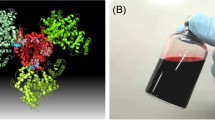Abstract
One method to increase the retention time of hemoglobin (Hgb) is to react it with a hydroxyethyl starch (HES) molecule. To examine this hypothesis, polymer-bound hemoglobin compounds were synthesized by the dialdehyde route. The electrophoretic mobility patterns indicate complete binding of the Hgb. Preliminary exchange-transfusion experiments in rates showed that they could survive for at least 10 h at Hct<10% when transfused with 6% HES-Hgb solutions. The retention time of the Hgb in the urine was increased to 12 h with these new polymers.
Similar content being viewed by others
References
Cerny, L. C., Stasiw, D. M., Cerny, E. L., Baldwin, J. E., and Gill, B. (1982),Clin. Hemorheology 2, 355.
Author information
Authors and Affiliations
Rights and permissions
About this article
Cite this article
Cerny, L.C., Cerny, E.L., Robach, J. et al. A blood substitute from hydroxyethyl starch and hemoglobin. Appl Biochem Biotechnol 10, 151–153 (1984). https://doi.org/10.1007/BF02783747
Received:
Accepted:
Issue Date:
DOI: https://doi.org/10.1007/BF02783747




